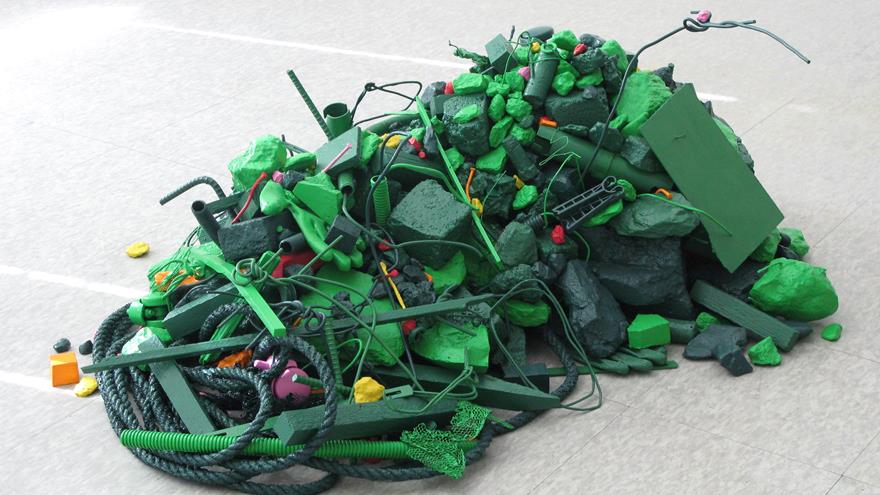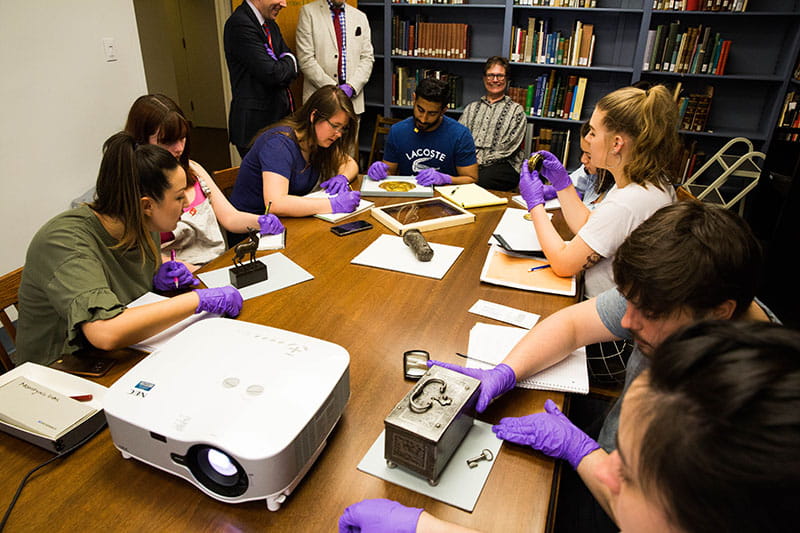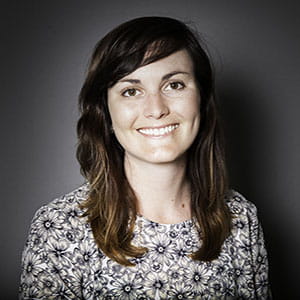Handle With Care: Course Takes Drexel Students Behind The Scenes at the Philadelphia Museum of Art

- Drexel’s Pearlstein Gallery Offers Spring Exhibitions Centered on the Healing Properties of Art and Creative Works
- The First Exhibition of Contemporary Nepali Artists in the U.S. Debuts in Drexel’s Pearlstein Gallery
- Entrepreneurial Game Studio's App Takes Stanzas to the Streets
- Chasing the Dragon: China in the Western Imagination on Display at Drexel’s Fox Historic Costume Collection

This piece is part of the new DrexelNow series showcasing "A Day in the Class" for some of Drexel University's most interesting and impactful courses.
The students taking ARTH 150 this term meet at the west entrance of the Philadelphia Museum of Art (PMA) after traveling from Drexel University’s University City Campus on a hot, sticky Wednesday afternoon.
There are eight students waiting in the lobby, chatting with and embracing each other before it’s time to make their way to today’s classroom. The instructors arrive to lead them through a nondescript door and into a non-public part of the Arms and Armor section of the museum, and the students stroll in seemingly unfazed by this rare access allowed to them.
The classroom is the Kienbusch Collection Library and students gather around a table in the room, the walls of which are lined with books. The camaraderie is palpable among these first-year art history majors in the Westphal College of Media Arts & Design and the few outside students in the class, who are majoring in graphic design or even finance. This is only the third year that Drexel has offered the art history major, and this is the first year that this course has been offered jointly with the museum.
“This year is terrific because Jack [Hinton] and Dirk [Breiding] and I are able to bring students to work behind the scenes to really interact and engage with works from the collection,” said Elizabeth Milroy, professor and department head for Art and Art History at Westphal.
“This year is terrific because Jack [Hinton] and Dirk [Breiding] and I are able to bring students to work behind the scenes to really interact and engage with works from the collection,” said Elizabeth Milroy, professor and department head for Art and Art History at Westphal.
This team of instructors have come together to give the students a chance to do what is necessary to really learn about art — observe it, hold it, even smell it.
“We’ve got works of art that were made to be used or handled, or in the case of arms and armor, worn,” Hinton said of the PMA collection. “They communicate with great immediacy the ideas of the artists and the people who owned them, the patrons that ordered them, in order to achieve something in terms of their self-representation or for some other reason. So, they’re primary sources, if you’re thinking in terms of art or design history, a thing that you should always go back to and start from.”
“We’ve got works of art that were made to be used or handled, or in the case of arms and armor, worn,” Hinton said of the PMA collection. “They communicate with great immediacy the ideas of the artists and the people who owned them, the patrons that ordered them, in order to achieve something in terms of their self-representation or for some other reason. So, they’re primary sources, if you’re thinking in terms of art or design history, a thing that you should always go back to and start from.”
“We have some budding registrars here,” Milroy said to some of the students based on their astute analysis.
Then, Hinton disappears into another room to retrieve some objects. Because of the fragility of the objects they will be handling, the students pass around a box of purple gloves and suit up. They then pair up and each team is given an object that they must try to identify or determine what time period it’s from. The students chatter, sketch, take notes — one student even finds a way to open her object, and decides to take a whiff. Her curiosity is rewarded: the telltale scent of sulfur tells her that the small embossed iron container is actually a Renaissance gunpowder flask.
“You don’t want to be too timid,” said Breiding, congratulating the student on this decision.
“You don’t want to be too timid,” said Breiding, congratulating the student on this decision.
“The sooner you get this kind of class on a pretty basic level, the better,” she said.
In addition to the PMA partnership, Drexel offers many opportunities for art history majors and students from across the University to get hands-on experience, Milroy added.
“We’re fortunate because students can work in The Drexel Collection and the Drexel Historic Costume Collection, as well as at the Academy of Natural Sciences,” Milroy noted. “Many students actually do co-ops in the collections.”
That being said, the value of study at the PMA is not lost on the current ARTH 150 students.
Mali O’Neal, a freshmen art history major, said that even though the course is required, it’s not at all what she expected — in a good way.
“I thought I was going to be sitting at a desk and learning about researching things online and it’s so much more fun than that,” she said. “Being able to interact with the objects is really exciting. Last week, I got to hold a sword from the 1600s. So that was really cool.”
“I thought I was going to be sitting at a desk and learning about researching things online and it’s so much more fun than that,” she said. “Being able to interact with the objects is really exciting. Last week, I got to hold a sword from the 1600s. So that was really cool.”
“I’m trying to be an art dealer one day, and actually being able to come in and look at these pieces in here from people who actually work in the art world, nothing could be better from the standpoint of going toward the profession, as opposed to just sitting in a lecture,” he said.
Outside of the hands-on experience, both students agreed that it’s the opportunity to work with great teachers and within a historical city-based University like Drexel that will really help set them apart in their futures.
“Philadelphia has so many museums,” O’Neal said. “I think one of my favorite things about doing art history at Drexel is that we’re surrounded by art and history. Philadelphia is one of the best cities in the United States for that.”
And for the PMA, the benefits are equally abundant.
“We think that it’s very important for us to be engaged with students so as to foster this interest and also train museum professionals of the future,” Hinton said.
Drexel News is produced by
University Marketing and Communications.
